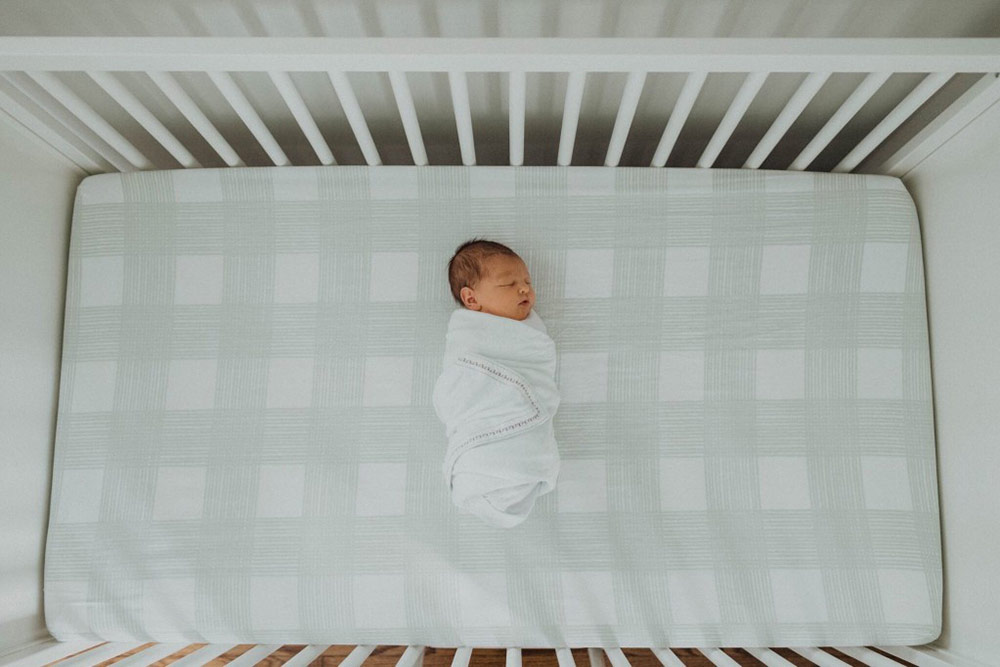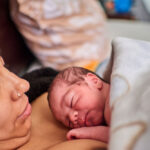Crib Mattress Cheat Sheet

Your little one’s crash pad is a pretty big deal. The place where she will rest her sleepy head at night should be approached with thought and consideration. Though it may seem like all mattresses are the same, the truth is that they’re far from equal across the board. Use this guide to help find your perfect match.
Design Elements
Mattresses pale in comparison at first glance, but their inner workings can be vastly different.
For example, a breathable mattress core is air-permeable by design, meaning air can pass through at all times. In fact, if you hold a blow dryer up to a breathable mattress, you should be able to feel the air come out on the other side. Other products boast buzzwords and phrases like organic crib mattress, hypoallergenic or non-toxic and eco-friendly materials, such as organic cotton.
Choosing what type of support core layer you prefer is a great place to start, as this will affect a product’s makeup, functionality and comfort. (Note: Your child’s mattress should always be firm to the touch regardless of core type. Do not use a soft mattress in your baby’s crib.)
Interior Options
Innerspring or coil core: This is a common mattress construction involving a layer(s) of coil springs that make up the support function of the mattress. This layer is usually paired with comfort layers, such as foam, latex or natural fibers.
Polyurethane foam core: A staple for bedding, this material’s quality is based on high- or low-density. The higher the density, the more resilient the support and overall performance for a longer period of time. A foam crib mattress should use high-density polyurethane to provide a safe sleep surface and prevent your baby from sinking too low into the mattress. Foam core mattresses are generally less expensive than their memory foam counterparts.
Memory foam: Also known as viscoelastic foam, memory foam is known for its ability to absorb and distribute pressure from the body, creating a conforming cradle that’s still well supported with firm foam.
Fiber core: A polyester fiber construction that offers a good balance of firmness and support for babies and toddlers alike. They are often made out of recycled materials and are lightweight in comparison to other products.
Exterior Details
It’s not just what’s on the inside that counts; the outer mattress features matter, too!
Mattress covers are just as diverse and make a big difference in maintenance and care. Not to be confused with a mattress pad, which adds padding and comfort to the top layer of a mattress, covers are used to protect from billions of bacteria: sweat, lint, dust, dander, bodily fluids, to name a few—that baby would otherwise be breathing in every night.
A removable mattress cover is often machine washable and easy to keep clean. You can also opt for a waterproof cover to protect against leaks, but make sure it’s also breathable if using a breathable mattress. Not doing so will defeat the purpose of your mattress choice.
Another important factor to consider is longevity. Size, single- or dual-sides and warranty all impact usage over time:
Size: A mini crib mattress or one used with a bassinet or portable crib will only allow for so much growth. Though great for the first few months of life (especially if you’re room-sharing), your infant will require the space of a standard crib as she gets bigger.
Sides: Some mattresses come with two different sides and offer dual firmness that cater to separate ages. The infant side is extra firm, while the toddler side may provide additional comfort as the risk of SIDS decreases after age 1. Though still a standard size for a crib, the toddler mattress can be transitioned to a toddler bed once your tot is ready to ditch the bars.
Warranty: Check to see if your product comes with a year warranty (or more), as manufacturing defects happen and replacements are sometimes needed.
Tips for a Better Buy
First of all, confirm that your possible pick isn’t currently recalled by visiting the Consumer Product Safety Commision website. In addition to offering firm support, it’s best to choose a mattress not made with synthetic foam. If that’s not a possibility, look for one that checks one (if not all) of the following boxes.
Certifications: There are many to sift through, but these seals certify that a mattress does not contain or release certain harmful chemicals.
- GREENGUARD Gold Certified: This ensures the interior products are low in chemical emissions (specifically formaldehyde), decreasing indoor pollution levels. Note that the certification Okeo-Tex allows for more formaldehyde and should not be used interchangeably with certain baby products.
- Global Organic Textile Standard (GOTS): A stringent process that makes certain textiles remain organic from harvesting of the raw materials to responsible manufacturing to labelling and distribution. This provides credible assurance to the consumer.
- Global Organic Latex Standard (GOLS): This process protects the integrity that a particular product contains at least 95 percent organic latex. GOLS should not be confused with USDA Organic when considering a latex mattress.
Additional components to avoid include chemical phthalates and flame retardants, as well as allergens and vinyl covers.
Suffocation Risk: The proper firm support of your mattress means it only fits fitted crib sheets—preferably breathable ones. The crib should be completely bare and free from stuffed animals, loose bedding, bumpers and pillows.
Pay close attention to how well your baby’s mattress fills out the crib frame as well. A good rule of thumb is to use the two-finger test. There should be no more than two finger-widths of space between the side of the mattress and the crib frame. A larger space poses a threat of entrapment between the two to your baby, which could result in injury or suffocation.
Our top pick
There are a handful of mattresses that meet the highest standards of parents, but our current choice is the breathable Newton Baby Waterproof Crib Mattress. Here’s why:
-It’s 100 percent breathable with a Wovenaire® polymer core (unique to the brand) that’s 90 percent air and 10 percent food-grade polymer.
-It comes with 2-Stage technology for infants and toddlers—both sides are fully water-resistant!
-The quilted waterproof cover is also breathable, so you don’t have to shop around for one to match the mattress core. It fits like a glove and is plush for your newbie while still safe.
-The mattress as a whole is 100 percent recyclable with no foam, latex, glue or springs included.
-It’s GREENGUARD Gold Certified and exceeds the highest industry emissions safety standards.
-You can try it risk-free for 100 nights to decide if it’s right for your family.
Win your own Newton Crib Mattress here! For more information on current safety standards for crib mattresses, visit federalregister.gov today.







